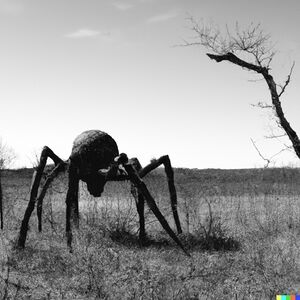Petal-Hial-Eda: Difference between revisions
NewZimiaGov (talk | contribs) No edit summary |
|||
| Line 1: | Line 1: | ||
{{Bassarid Article}} | {{Bassarid Article}} | ||
[[File: | [[File:PetalHial22.jpg|thumb| Though most people are at least somewhat afraid of it due to its monstrous appearance, the Petal-Hial-Eda is actually a very gentle, passive creature.]] | ||
Despite its frightening appearance, this large, eight-legged creature is very passive and non-aggressive in most of its day-to-day activities. Known to reach heights of over two meters, and weights of over 200 kilograms, the '''Petal-Hial-Eda''' is known to have a particular affinity for the taste of the sap produced by the [[Adraso-Oname]], a tree which grows in particular abundance in the [[Depths of Anatina]]. Wherever one finds Adraso-Oname, one can expect to find Petal-Hial-Eda. Many residents of northern [[Corum]] are unwilling to work on Adraso farms, out of fear of the herbivorous and genuinely harmless Petal-Hial-Eda. | Despite its frightening appearance, this large, eight-legged creature is very passive and non-aggressive in most of its day-to-day activities. Known to reach heights of over two meters, and weights of over 200 kilograms, the '''Petal-Hial-Eda''' is known to have a particular affinity for the taste of the sap produced by the [[Adraso-Oname]], a tree which grows in particular abundance in the [[Depths of Anatina]]. Wherever one finds Adraso-Oname, one can expect to find Petal-Hial-Eda. Many residents of northern [[Corum]] are unwilling to work on Adraso farms, out of fear of the herbivorous and genuinely harmless Petal-Hial-Eda. | ||
Revision as of 05:50, 21 August 2022
Despite its frightening appearance, this large, eight-legged creature is very passive and non-aggressive in most of its day-to-day activities. Known to reach heights of over two meters, and weights of over 200 kilograms, the Petal-Hial-Eda is known to have a particular affinity for the taste of the sap produced by the Adraso-Oname, a tree which grows in particular abundance in the Depths of Anatina. Wherever one finds Adraso-Oname, one can expect to find Petal-Hial-Eda. Many residents of northern Corum are unwilling to work on Adraso farms, out of fear of the herbivorous and genuinely harmless Petal-Hial-Eda.
Found in 9 out of 20 Pallisican cities in Corum, this species is common.
Cult of the Petal
One of a handful of species in Corum which are regarded as sacred, the Petal-Hial-Eda is revered by followers of the Cult of the Petal, a radical variation of the Flowing Path of the Pallisican Religion, which encourages its followers to induce visionary trances by consuming mushrooms that grow on the scat of the Petal-Hial-Eda. Followers of the Cult of the Petal can often be found in the Pallisican wilderness, tracking and following Petal-Hial-Eda across the country-side. The Petal Cults have in recent years been heavily influenced by the influx of practitioners of Face-Changing Magic into the region surrounding the Depths of Anatina.
Habitat
The range of the Petal-Hial-Eda extends across 22.41% of the landmass of Corum. A substantial majority of the species' range - 82.41% - lies in the Mediterranean climate regions of northern Corum. With that said, the Petal-Hial-Eda can also be found in the temperate and continental climate regions which run along Corum's east coast. Although the Petal is a species which overwhelmingly prefers the warm climate of northern Corum, 2.3% of the species' range lies in the eastern reaches of polar Hypernostria. Petal-Hial-Eda which live in polar regions are believed to be considerably more aggressive towards humans than their warm-weather counterparts.
The Petal-Hial-Eda is primarily a low-land species, though at least 7% of the species' range is believed to extend into the Riponian Highlands. Populations of the Petal have been observed as far inland as the eastern edge of the Central Riponian Mountains.
It is found in the eastern part of the Thraci Confederation and is frequently inhabited in forest areas, this species is very easy to find as mixed forests are common in the region.

